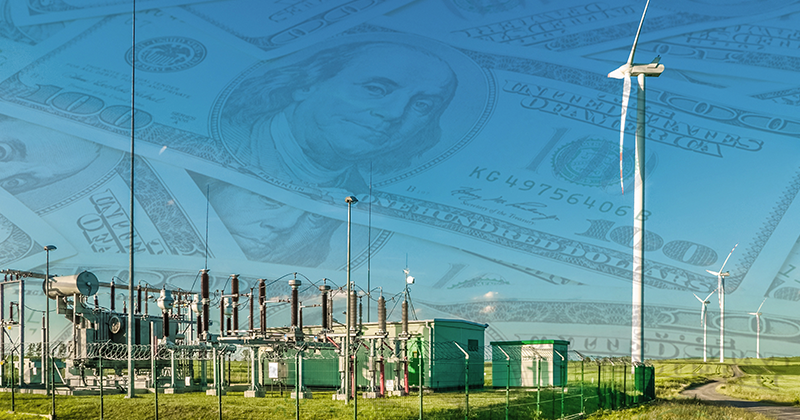
Through the Infrastructure Investment and Jobs Act (IIJA), also known as the Bipartisan Infrastructure Law (BIL), and the Inflation Reduction Act (IRA), Congress has authorized nearly $400 billion[1] to be invested in U.S. energy infrastructure over the next decade. The combined policies provide an unprecedented amount of federal funding available via grants, tax credits, loan guarantees, and incentive payments. The IIJA and IRA collectively present a unique, once-in-a-generation opportunity for energy companies and utilities to update their aging infrastructure, improve system reliability and resilience, develop clean energy projects, and reduce emissions, while limiting rate impacts for customers.
However, navigating the myriad available funding opportunities can be daunting given the scale and transformative nature of the IIJA and IRA. Further, the legislation stipulates that federal funds must achieve numerous policy priorities, including, but not limited to, the development of domestic manufacturing (i.e., Buy America), support for union labor and high-quality jobs (i.e., Davis-Bacon Act), and at least 40 percent of project benefits flowing to federally identified disadvantaged communities (i.e., Justice40 Initiative[2]). Given the nuanced requirements and complex objectives outlined in this legislation, potential applicants need to develop a clear strategy for targeting federal dollars and plan ahead to ensure that they are prepared to apply as opportunities become available.
The figure below summarizes the typical steps involved in the federal grant application process. The timing between steps may vary by program, but there is often limited time to complete key application components. For example, we have seen initial IIJA funding rounds with approximately one month between the release of the funding opportunity announcement (FOA) and concept paper deadline.

In our experience, there are five keys to successfully approaching IIJA and IRA grant opportunities:
1. Prioritize Funding Opportunities Based on Overall Strategy
The process of applying for federal grants can be a time-consuming and arduous cycle. Further, the post-award requirements can be even more substantial due to the complex compliance and reporting involved. Given the volume of opportunities for funding presented by the IIJA and IRA, energy companies and utilities should carefully consider which programs are best aligned with their individual strategic objectives, system needs, and stakeholder priorities. For example, certain programs are specifically designed to provide investments in rural or remote areas which may not be well aligned with a given utility’s service territory. Thus, to successfully capitalize on applicable funding opportunities and limit resource constraints during the application and award process, applicants should be judicious in determining which opportunities to pursue and carefully develop proposals that offer the greatest benefit or impact to their business model and stakeholders. Given the short timeframes from FOAs to concept paper, it is also extremely beneficial to have ideas for potential projects aligned with overall strategy at least partially developed in order to move quickly and develop a quality application once a funding opportunity is announced.
2. Identify Team and Develop Management Structure to Support Grants
Given the short turnaround between FOAs and initial application deadlines, it is critical to have a project management structure in place with the core team members identified to develop grant proposals. This is especially true for organizations with limited experience or internal expertise in writing grants. To successfully manage the grant process, applicants should identify internal subject matter and technical experts across functions (e.g., engineering, project management, construction, procurement, community relations, HR, labor relations, etc.) who will be required to provide input on project proposals. Those team members will need to be aware of grant requirements to balance the workload with other responsibilities and on-going efforts. Additionally, applicants will need to establish an internal governance structure or steering committee to make decisions and offer overall guidance throughout application development, award negotiations, and project execution. Aligning the goals of executive and project execution teams is critical to ensure that the highest-value grant opportunities are being targeted and that an internal governance structure is in place to oversee a seamless transition from proposal to implementation and execution.
3. Evaluate Potential Value Stacking of Funding Opportunities
The IIJA and IRA provide a complex and overlapping set of incentives that can take the form of tax credits or loan guarantees in addition to federal grants. Thus, applicants should consider whether there is potential to “stack” funding opportunities if a proposed project could qualify for multiple programs. Especially for innovative, first-of-a-kind projects, stacking federal and/or state incentives could provide additional benefits for applicants and maximize funding opportunities. However, this would also add complexity to the application and may require additional reporting on the duplicative funding to ensure that project costs are not allocated to multiple programs.
4. Focus on Community Benefits and Creation of Quality Jobs
Guidance provided by federal agencies administering funds from the IIJA and IRA have noted that grant proposals will be evaluated based on numerous factors, including how the applicant incorporates the principles of equity, justice, and advancing accessible, good-paying jobs with the free and fair choice to join a union. The legislation directs agencies to ensure that grant awards are aligned with the federal government’s Justice40 Initiative and demonstrate a commitment to American workers. As such, successful grant applicants will need to carefully consider how they will engage with communities, stakeholders, and labor to align their proposal with the numerous policy priorities outlined in the legislation. To maximize community benefits, utilities should leverage existing partnerships to identify community needs and build support through active engagement with stakeholders, especially historically disadvantaged communities, likely to be impacted by the proposed project. For applicants with well-defined environmental, social, and governance strategies and active climate mitigation programs, there may be an opportunity to align grant applications with existing efforts underway to address similar state or local policy objectives. Also, similar to aligning strategy and developing project ideas prior to funding announcements, it will be important to begin to build community relationships and potential partnerships prior to the relatively short application process.
5. Understand Post-Award Reporting and Compliance Requirements
The federal funds available via the IIJA and IRA grants, while significant, come with a diverse and complex set of reporting requirements throughout the application, award negotiations, and post-award during the execution of the project. These requirements include, but are not limited to, reporting on project management activities (i.e., execution of project tasks to inform go-/no-go decisions for continued funding), compliance with environmental and labor codes (e.g., Davis-Bacon Act requirements to ensure that all workers involved with the project are paid wages that meet or exceed prevailing rates for comparable projects in that locality), and financial reports (e.g., accounting of costs to demonstrate appropriate cost-share between the applicant and federal funding). Applicants should be aware of the broad and complex requirements prior to submitting applications for grants and ensure that the appropriate governance and project management structure is in place to manage reporting once grants are awarded.
In Summary
The IIJA and IRA provide an unprecedented amount of federal funding to help energy companies and utilities improve U.S. energy infrastructure, advance climate resiliency, and reduce emissions. However, the application and award process for federal grants can be time-consuming and onerous for applicants to develop proposals and then meet rigorous compliance and reporting requirements. Companies considering pursuing IIJA and IRA funding should align project proposals with their overall strategy, be judicious about which opportunities are pursued, and plan ahead to ensure that the grants team, governance structure, and community partnerships are in place to quickly develop applications when new opportunities that are good fits become available.
[1] https://www.whitehouse.gov/environmentaljustice/justice40/
[2] https://www.brookings.edu/research/the-start-of-americas-infrastructure-decade-how-macroeconomic-factors-may-shape-local-strategies/



